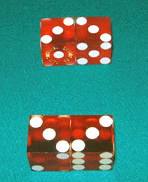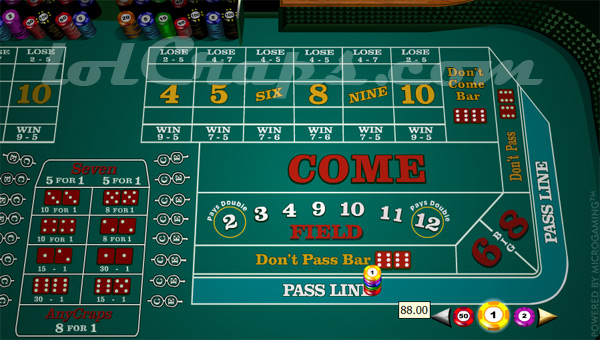Choosing the right dice set and using SRR
This page is the second part of the dice control guide. Once you have the basics down, such as throwing the dice level and parallel to the surface of the craps table, then the next step is to choose a good dice set and really start to apply your newly taught skills. We will talk about two major concepts of dice setting and precision shooting: stopping the dice on the axis and correlation.
First, dice sets are very important and paramount. This is what you do to get them "set" before throwing them. Essentially, you start off by sticking the two dices together in order to throw them along an axis as if it were a solid rectangular block. With that, you are placing certain numbers on top and other numbers on the sides. You can align them to make ideal combinations on the sides of the dice to produce the desired effect. I added a picture of what set dice look like below. This is an example of the 3V dice set with a 6 on the top face. There are many, many different dice sets to experiment with and they make certain numbers appear more efficiently than others. Also, each shooter is different so some sets work better with people than others.

Correlation means that the number on one die is dependent on the the number of the other die. Once you are able to control the outcome of the dice after a roll, then you have achieved correlation, though it may not be perfect. The goal is to have your dice be thrown and stop on the axis that it is thrown on. This is similar to what I said before where you would like both dice to be thrown as if they were glued together and spin on a similar axis. When they hit the wall, they should break apart but you want them to spin an equal number of times so that they still land "on axis" on the numbers that you are trying to throw.
I have to stress that it is more important to just throw the dice perfectly on axis than to get them to stop rolling on axis because it is very hard to do this after they bounce off the wall. Just focus on throwing them perfectly, which is the element that you can control. The rest will just happen on its own and you will win more frequently. Just think of dice control as an additional mathematical edge where your odds improve over the long run even though it may not be apparent. The better your skill gets, the higher your edge goes. Though, if you have been doing this for years, the grand masters can actually become good enough to get the dice to stop on axis!
Dice Setting and the "Sevens to Rolls Ratio" (SRR)
sevens to rolls ratio or SRR is a great indicator for how well you do as a crapshooter. It rates how well your skill level is and it gives you information about your natural style. To calculate and find your SRR, players must begin by counting their total rolls and the number of times that a seven has been rolled. For example, you can count up 100 throws to find this data. Players may do this with hard way numbers and craps numbers as well. To calculate the ration, just divide your total number of 7s by the total number of rolls.
The SRR is related to the actual true odds of rolling random numbers over the long term, so you have to have a large sample size to be accurate. If your throws are completely random, you should have a ratio of 1:6 for sevens to total rolls. In order to start beating the house edge on the pass line and come bets, you should have a ratio of 1:6.1 or greater. Eventually, when the ratio gets to 1:6.4, many experts say it is safe to start playing with real money against the casino. A ratio of 1:6.5 becomes very good and anything higher is excellent. Note that the ratios can be reversed as well. If you are trying to shoot 7, a ratio of 1:5.5 means that you are throwing a lot more sevens and you can benefit more with the any sevens bet.
A few things to watch for is the double pitch problem when one of the dies rolls a distance of two faces or 180 degrees more than the other. It is usually caused by a faulty release of the dice and from the curvature of the fingers placed on the surface of the dice. A good way to correct this is to set the dice in order to have 7s showing on the near faces and the top. Otherwise, keep on practicing and watch what your fingers are doing because this is usually the cause of the problem. The ring finger and the thumb tend to be the biggest culprits.
When trying to figure out how to choose your dice set, you should take in mind what kinds of throws work best. Look at how well the dice actually stop directly on the axis. This is hard to do and many people cannot do this. If you are having trouble getting to stop on the axis, then set the dice with sevens on all the faces that you can. If you do get your dice to stop on the axis often, then do the opposite and do not put as many sevens on the faces.
Stopping on the axis means that the dice are still rolling together at the same rate, even if they break apart after they hit the wall. Then they stop exactly the way they should and land in a similar orientation that you threw them in. This is the ideal goal of precision shooting. Remember, the wall and the bumps on the sides of the craps table are designed to mess up the axis and produce more randomness. So the goal is to get the dice to land on the table as quickly as possible after they hit the wall, which is best done using a backspin technique.
In summary, the goal is again to throw the dice parallel and level to the surface of the table. You want to produce a backspin if possible to counteract hitting the wall and you want to dice to land as close to the opposite wall as possible after hitting it to produce less randomness. Keep on practicing and figure out what your SRR to find out if you have good correlation going on. Then choose your dice set based on how well you throw sevens or not, but also factor in your ability to get the dice to stop on axis.
At the beginning of the article, I posted a link to my first part of dice control. Visit that page and then look at the links on that page to visit those other sites and look at all the different types of dice sets and which ones work best for different numbers and players. This might all seem complicated at first but really, this becomes very easy once you start practicing. My word of advice is you can not become good at dice control by reading. You have to acquire the skill by throwing real dice. Remember that this is a skill that you can learn and take with you the rest of your life and it's actually one of the easiest and safest ways to take advantage of the casino without having to know a lot of mathematics (unlike card counting in blackjack).


 US Players and Credit Card, BitCoin Deposits Accepted!
US Players and Credit Card, BitCoin Deposits Accepted!


